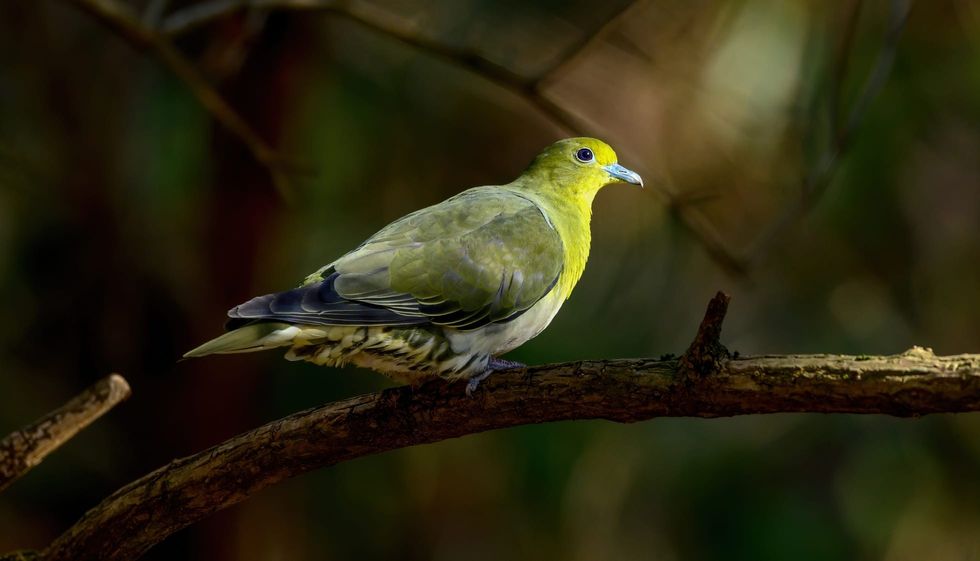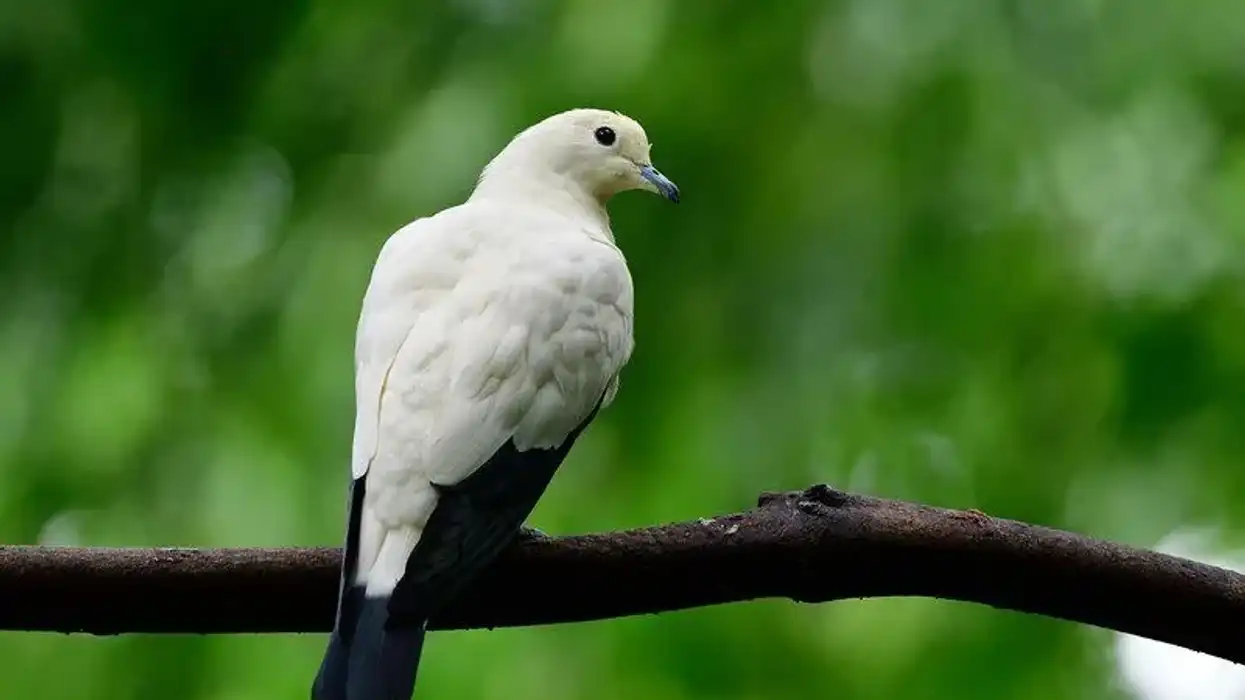Do you like green pigeons? Then here we have all the information on the white-bellied green pigeon.
The white-bellied green pigeon (Treron sieboldii) is a kind of pigeon that is part of the family Columbidae of the Animalia Kingdom. These birds can be seen in parts of southeast Asia, mainly in countries, like China, Japan, Thailand, Laos, and Vietnam.
They have been reported as rare to uncommon birds within their habitat range. They may be uncommon, but their population is only threatened due to the destruction of habitat, and they have been declared as a species of Least Concern.
They live in the mixed forests of temperate areas and secondary forests of coastal areas. These are social birds so that they can be seen in flocks of 10-100 birds at a time.
They build shallow, flimsy nests about 6.6-9.8 ft (2-3 m) above the ground. These birds are not endemic.
Read on to know more about the white-bellied green pigeons and if you like this article, then also check out pigeon tremex facts and pink-necked green pigeon facts.
White-Bellied Green Pigeon Interesting Facts
What type of animal is a white-bellied green pigeon?
The white-bellied green pigeon (Treron sieboldii) is a pigeon bird species.
What class of animal does a white-bellied green pigeon belong to?
The white-bellied green pigeon (Treron sieboldii) belongs to the family Columbidae and class Aves of the Animalia kingdom. The white-bellied green pigeon belongs to the genus Treron. These birds are similar to other green pigeons, like the yellow-footed green pigeon.
How many white-bellied green pigeons are there in the world?
The population of this species of pigeons in an exact number is not known. However, they have been reported to be very rare to uncommon within their natural habitat range, and their population in their habitat range is showing a decreasing trend still.
Where does a white-bellied green pigeon live?
The white-bellied green pigeon (Treron sieboldii) is a bird species that has four subspecies - Treron sieboldii sieboldii, Treron sieboldii fopingenis, Treron sieboldii sororius, and Treron sieboldii fopingenis. The geographic range of these four subspecies is divided within southeast Asia. These pigeon species are primarily found in countries like Japan, China, Thailand, Vietnam, and Laos.
What is a white-bellied green pigeon's habitat?
The primary habitat of this species of pigeons within their geographic range is many kinds of forests. They can be found in secondary forests of coastal areas and dense mixed woodlands of temperate regions.
These birds are mainly seen up to an elevation range of 1.4 mi (2300 m) in Taiwan, up to 1 mi (1600 m) in China, and up to 0.9 mi (1400 m) in Japan.
Who do white-bellied green pigeons live with?
White-bellied green pigeon (Treron sieboldii) is a social species of bird. Flocks of around 10 birds forage together. They can also be seen in flocks of hundreds of birds within their natural habitat range.
How long does a white-bellied green pigeon live?
The exact lifespan of the white-bellied green pigeon (Treron sieboldii) is not known. However, pigeons, in general, live for about 15 years on average.
How do they reproduce?
Due to a lack of research, not much information is known about the white-bellied green pigeon (Treron sieboldii). Their nesting season within their habitat range occurs around May-June in Japan. They make their nests around 6.6-9.8 ft (2-3 m) above the ground.
These shallow and flimsy nests are cup-shaped and made of twigs. After copulation, the female lays about two eggs on average that are usually white-colored.
Both the male and female birds incubate the eggs for the next 15 or so days. Mostly the males incubate them during the daytime. The hatching of the eggs, the chicks fledge in the next 15 days.
What is their conservation status?
The conservation status of the white-bellied green pigeon (Treron sieboldii) according to the International Union for Conservation of Nature is listed as of Least Concern. They are not facing any great threats within their natural habitat range as of now, so no conservation actions are still being taken.
White-Bellied Green Pigeon Fun Facts
What do white-bellied green pigeons look like?

The white-bellied green pigeon (Treron sieboldii) is a big bird. They have an overall greenish appearance. They have a smooth golden tinge on their breast and an almost non-visible golden tinge on the forehead and crown.
Their belly is pale white and a dash of purple can be seen on their wing-coverts which is lacking in the females. The breast and forehead of the females are greenish-yellow.
The cream undertail-coverts of the birds are streaked with grayish-green color. They have a bill that has a gray tip and grayish blue base. Their feet are purplish-red to red in color.
How cute are they?
This species of pigeon is actually very beautiful owing to its gorgeous plumage. They are also not known to be aggressive in nature.
How do they communicate?
This species of pigeons communicate vocally and visually. They have a rapid muttering call that sounds like 'popopopo'. Their song sounds a lot like a flute going 'oh-aoh-ah-oah-oh-aoah'.
How big is a white-bellied green pigeon?
An adult white-bellied green pigeon (Treron sieboldii) is about 13-14.2 in (33-36 cm) in length. They are slightly smaller than green imperial pigeons, which are about 17.7 in (45 cm) in length.
How fast can a white-bellied green pigeon fly?
The exact speed at which this species of pigeons fly is not known. However, pigeons, in general, have the ability to fly at a speed of 77.6 mph (125 kph). Their speed can even reach up to 92.5 mph (149 kph). They also have the ability to fly continuously for a long time.
How much does a white-bellied green pigeon weigh?
Due to a lack of research, the exact weight of this species of pigeon is not known.
What are the male and female names of the species?
The males of the species are called cocks, and the females of the species are called hens.
What would you call a baby white-bellied green pigeon?
A baby white-bellied green pigeon (Treron sieboldii) is called a chick or a hatchling.
What do they eat?
Similar to the African green pigeon species of the same family, Columbidae, these pigeons are herbivorous in nature. They are largely frugivorous but also have been seen to feed on acorns.
Are they dangerous?
They are not known to be aggressive or dangerous towards humans or otherwise in any way.
Would they make a good pet?
These species of bird are wild pigeons, and there have been no reports of these pigeons living as pets. It's better to leave them in their natural habitat range where they can live happily.
Did you know...
The white-bellied green pigeon (Treron sieboldii) is a species of bird that is mainly resident in nature. All residents of China, Thailand, Vietnam, or Laos have been seen to move only locally for food. The population of Japan seems to be migratory, but they probably move within the range of the country.
The population of Hokkaido is mainly seen in summer, around May-September. Some winter populations can be noticed in Okinawa and rarely in the Ryukyu Islands. Singles have been found around Hebei of northeast China.
What type of nests do white-bellied green pigeons build?
The nests of these species of bird are shallow and flimsy. They are cup-shaped, built about 6.6-9.8 ft (2-3 m) above the ground, mainly with twigs.
What color are the white-bellied green pigeon's eggs?
The female white-bellied green pigeon lays around two eggs on average, which are white in color.
Here at Kidadl, we have carefully created lots of interesting family-friendly animal facts for everyone to discover! Learn more about some other birds from our Canyon towhee facts and blue-footed booby bird facts pages.
You can even occupy yourself at home by coloring in one of our free printable pigeon coloring pages.









